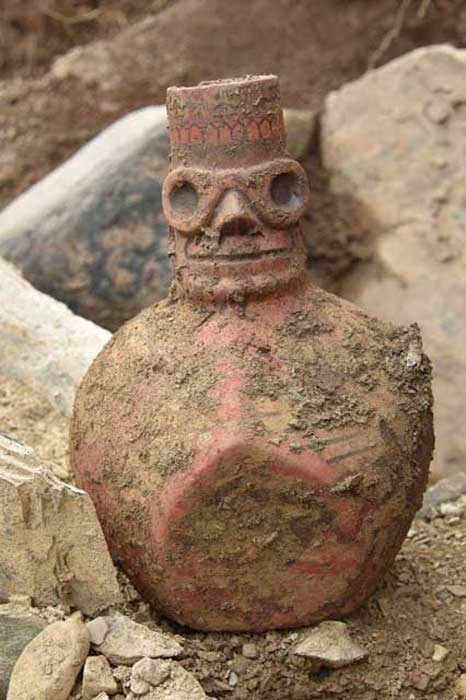
Study of Ceramics Provides New Thinking on Origins of First Peruvian Empire
The Andean nation of Peru has been the home of many important pre-Columbian societies. But their origins and development still holds many questions. Now a number of ceramic pieces are throwing light onto the first pre-Columbian cultures in the area, one which laid the foundation for future empires, such as the Wari and the Inca. The ceramics are providing unprecedented insights into the evolution of the Wari Empire and have revealed the importance of the earlier Huarpa culture in its development.
The stylized clay pottery was found at a site, called Wari, in the Ayacucho Valley, in the highlands of Peru. The archaeological site is located some 16 miles (24km) northeast of the modern regional capital, also called Ayacucho. According to the Expreso, this site is considered to be ‘the capital of this complex and well-organized pre-Hispanic civilization (600 AD-1,200 AD)’.
The Wari Empire
The Wari were an agricultural people whose development of terrace agriculture, allowed them to become the first state in the region from 600 AD – 1200 AD, before the Inca. They established an informal empire over an area that covers much of modern Peru by establishing colonies and using ritual ceremonies to ensure the obedience of other cultures. The Wari culture collapsed after a period of drought and many of its sites appear to have been ritually destroyed by the inhabitants.
Some 45 pieces of pained clay pottery were unearthed at the site in the valley. Many had to be painstakingly pieced together because of the Wari practice of breaking ceramics. The ceramics found at the Wari complex were examined by archaeologists from the San Cristobal de Huamanga University. The decorative elements in the pottery ‘include representations of coastal animals and marine products (seaweed, fish, octopus)’, according to the Archaeology News Network. They come from a variety of stages in the development of the Wari.
- Peruvian Archaeologists Unearth Silver Artifacts, a Massive Temple and an Astronomical Observatory Near Cusco
- Pre-Incan Culture Didn’t Rule by Pillage, Plunder and Conquest

A decorative Wari vessel found at the Espiritu Pampa archaeological site in the Southern Cusco. ( Peruvian Ministry of Culture )
The ceramics are transforming the way that we understand the development of the Wari culture. It had previously been believed that they had been decisively influenced by the Nasca (100 BC-700 AD) and Tiahuanaco cultures (200 BC-800 AD). There are undoubted links between the Wari and these cultures, as seen in the style and motifs on the ceramics.
However, Jose Ochatoma, the lead researcher on the project, has stated that ‘Wari is not the result of simultaneous influences of Nasca and Tiahuanaco cultures, as previously thought’ according to Archaeology News Network. These cultures influenced the Wari when they had already developed a sophisticated culture and state, of their own. The ceramics show that there were also strong influences from the Huarpa culture. So who were the predecessors of the Wari?
The Huarpa Culture
The identity of the culture that decisively shaped the Wari may already be known. According to the ATS website underneath the ‘capital city of the Wari Empire ….an older city corresponding to another much older pre-Columbian culture, the Huarpa culture’ has been found. There is a great deal of evidence indicating that the Huarpa culture inhabited the Ayacucho Valley before the emergence of the Wari.
- “Gate of the Sun” at Tiahuanaco, Bolivia
- Origin Myths of the Inca Civilization & Piecing Together Royal Heritage

Ruins of Huari (Wari) at Ayacucho, Peru. (Peru Adventure Tours)
The Huarpa culture was an agricultural society and they seemed to have been pioneers in the development of terrace agriculture and established a sophisticated society in a very inhospitable environment. According to the Lifepersona website, ‘Huarpa civilization lived between 200 and 550 AD, when it began its decline and eventual disappearance.’
Based on the limited archaeological evidence that we have, it appears that they lived in scattered agricultural communities. They developed a black and white style of pottery that was widely distributed around the region. It appears that they worshiped sacred mountains, a practice which continues in local indigenous communities.
Origins of the Wari Empire
The collapse of the Huarpa, culture was possibly the result of climatic change, overuse of resources and overpopulation. However, the downfall of this culture now looks to have led to the emergence of the Wari. They were the successors of the Huarpa in the Ayacucho Valley, and from here they created a great empire. According to encyclopedia.com, they ‘established the economic foundation for the later development of the Huari (Wari) state that emerged in the Ayacucho Valley’. The Huarpa’s accomplishments in irrigation and terrace agriculture allowed the Wari to eventually become an empire.
The study of the Wari ceramics is demonstrating that the Nasca and others are not the origins of that society and empire. Rather, along with the archaeological evidence, it shows that it was probably the successors of the Huarpa or at least had a combination of influences. More research is needed to understand the nature of the relationship between the Huarpa and the Wari.
Top image: Ceramics give evidence of Peru’s first empires Source: Andina / Juan Carlos Guzmán Fair Use
By Ed Whelan















